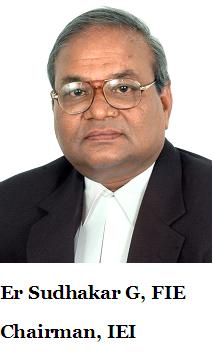
The Institution of Engineers (India) came into being in 1920 as a result of the need felt for such a body by the industrial commission of 1916-18. Dedicated to promote, advance and accelerate the art, science and practice of engineering and to harness natural resources for the benefit of the nation and to encourage high standard of professional conduct with the purpose of enhancing its service.
The Institution was granted the Royal Charter by the King Gerorge V, in 1935, “to promote and advance the science, practice and business of engineering in all its branches in India”.
Starting with this humble beginning the Institution of Engineers (India) is now an unique professional body encompassing 15 engineering disciplines and with an overall membership of over 0.9 million.
Since inception in 1920, for the Institution of Engineers (India), has been a long and untiring journey, long enough, yet sustaining the test of times, characterized with multi-dimensional and multi-disciplinary growth and accredited with vital contributions towards educational, technological, industrial and economic development of our country. The quest for professional excellence never allowed the national frontiers to contain the Institution, and it moved on to occupy the rightful and highly regarded positions on almost all relevant and prestigious world organizations for ultimate service to the International community.
The Institution has been endeavouring to act as a think tank to the Governments on all Engineering and Technological complexities by offering appropriate solutions and generating awareness among the general public. Since inception it had organized a number of activities such as Popular Lectures, National Conventions; Indian Engineering Congress and International Conferences. It had several eminent engineers as its Chairmen, Hon. Secretaries and Members who have made a mark for themselves in the professional field and also contributed greatly to the development of the Institution. The Centre also organized Silver Jubilee, Golden Jubilee on a large scale which received high appreciation from all.
The Hyderabad Centre was started in 1938 hardly with 60 members. Due to the enthusiasm and devotion of the members the Centre was developed fast. The Hyderabad State Centre was transformed into Andhra Pradesh State Centre in 1956 enlarging the geographical jurisdiction.
The Andhra Pradesh State Centre has paid its humble homage to the Great Engineer Statesman of India, Bharat Ratna , Dr M Visvesvaraya, by erecting a bronze statue almost in front of the Centre’s building at the traffic island on the Raj Bhavan Road. The Statue was unveiled on 12.11.1966 by the then President of India, Bharat Ratna Sir S Radhakrishna.
The Andhra Pradesh State Centre has 9314 Corporate Members on its rolls. At present there are Local Centres at Vijayawada, Visakhapatnam, Tirupathi, Warangal, Kakinada and Kadapa attached to Andhra Pradesh State Centre.
The Government of Andhra Pradesh in G.O. Ms. No. 234, dt. 3.6.1987 have recognized the Institution of Engineers (India), A P State Centre as a professional body with whom the Government can have continuous interaction to refine the procedure for improving efficiency and economy and for promoting technical excellence in the execution of public works.
The A P State Centre had the privilege of receiving the award in the first year of its institution and successively seven times i.e. 1999-2000; 2004-05; 2005-06 and 2006-07; 2008-09; 2009-10 and 2010-11.
On 15th November, 2012, the inaugural function of the Platinum Jubilee Celebrations was held at Ravindra Bharathi and on 14th November, 2013 as decided, the culmination of the Celebrations is concurrently with All India Seminar on “Green Initiatives in Mechanical Engineering” is being organized in the Centre.
It is indeed a great event for every one of us. Hon’ble Members of State Centre Committee have extended whole hearted support in making these celebrations a grand success. The Chairman of PJC Sub-Committee has spent their valuable time for designing and executing these activities which include an exhibition of publications and historical reminiscences.
It must be mentioned here that the band of devoted staff of this Centre has been a real strength behind the growth and efficient functioning of this Centre.
